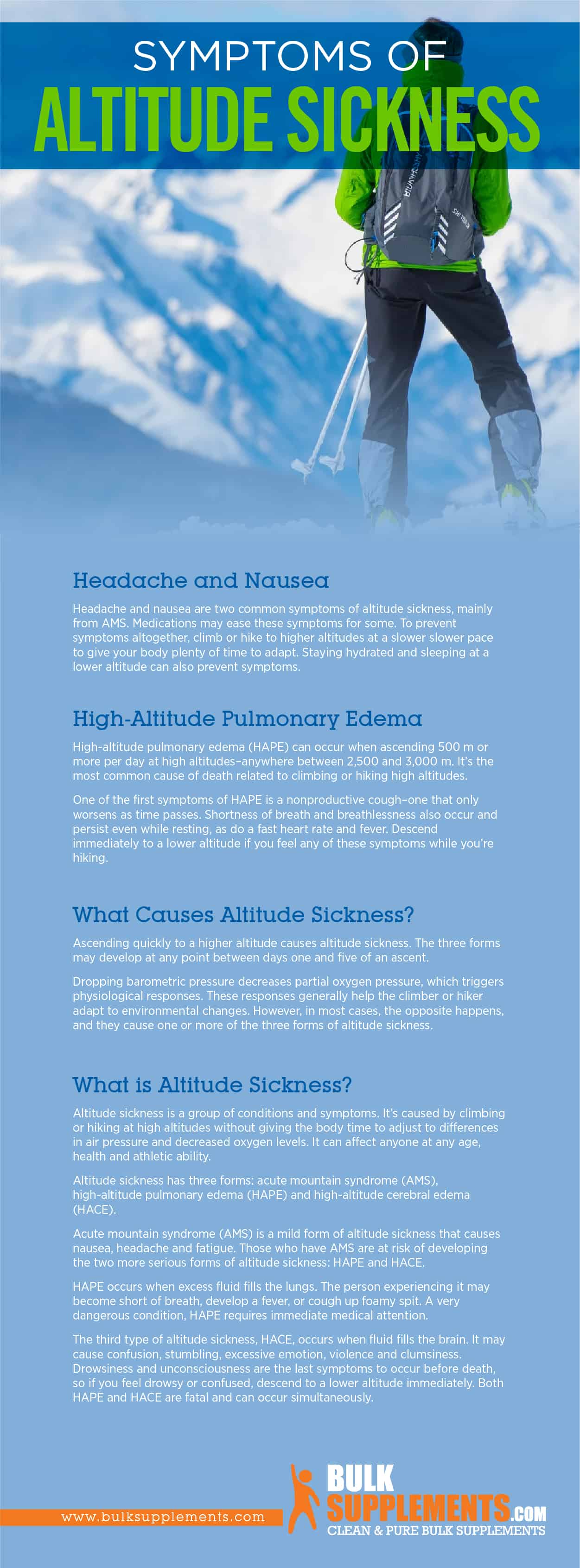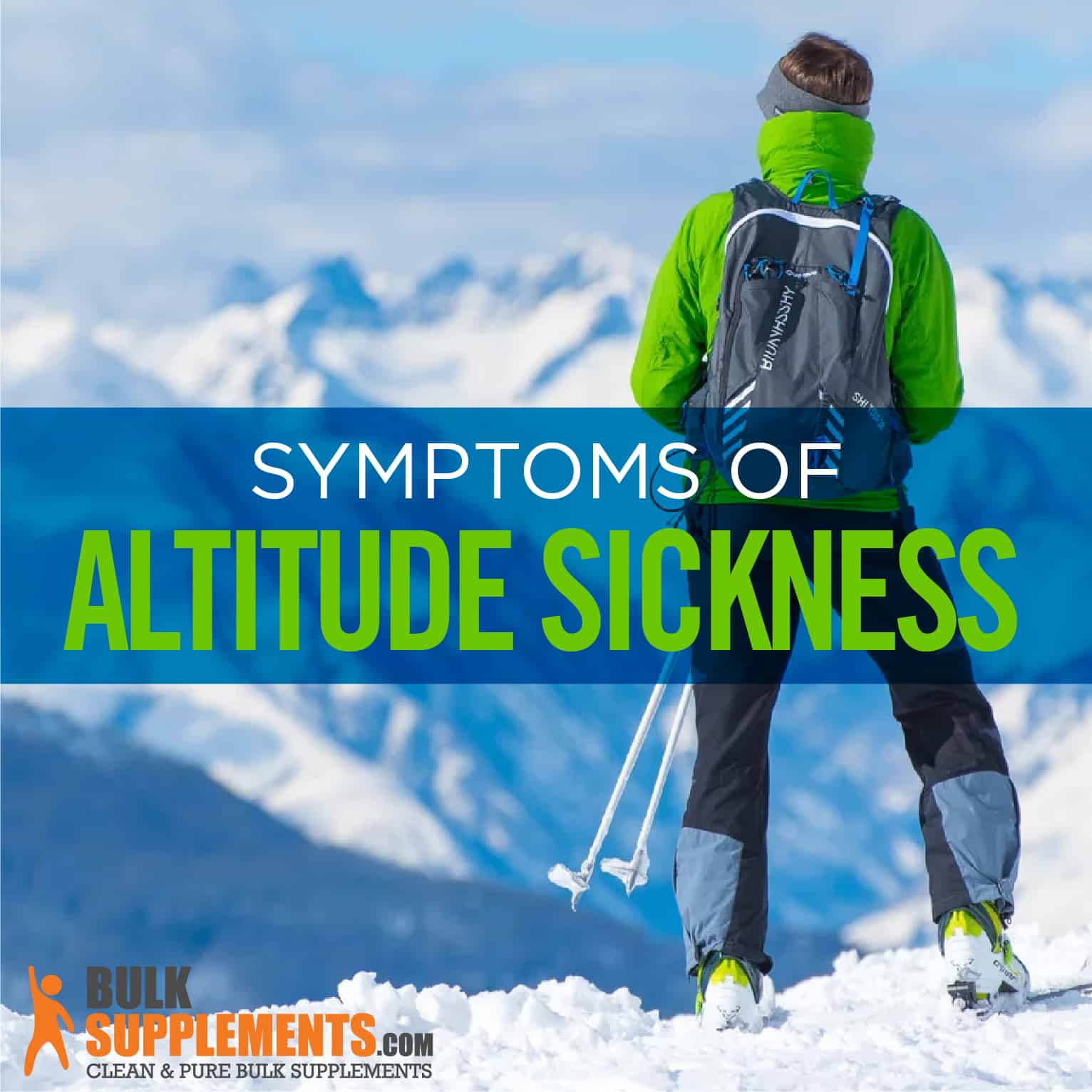Have you ever traveled to a region high above sea level and felt lightheaded or dizzy? You might have had altitude sickness or “mountain sickness.” The physiological experience happens because the body travels to locations at a higher altitude than your body can handle. It’s an enormous concern for travelers, particularly athletes or people who like to hike, snow ski, or mountain climb.
When your body hits a higher altitude than it is not accustomed to experiencing, the body feels pressure, and the amount of oxygen available is not the same. Even higher altitudes where the environment is colder with low humidity and more ultraviolet radiation can also adversely affect the body. The “new” environment may cause nausea, weakness, and trouble breathing.
Altitude sickness is profoundly uncomfortable, but it is dangerous and may even cause death. It is rare that a severe condition of altitude sickness happens or is life-threatening. Mostly, people usually experience a moderate or mild case of altitude sickness, which gradually lessens as the body becomes familiar with the climate and new location. If you enjoy traveling, it’s a good idea to become familiar with natural and preventive solutions that can curtail the chances of suffering from altitude sickness.
What is Altitude Sickness?
Altitude sickness is a group of conditions and symptoms. It’s caused by having climbed or hiked at high altitudes without giving your body time to adjust to air pressure differences and decreased oxygen levels. It can affect anyone at any age, health, and athletic ability. (x)
Altitude sickness has three forms: acute mountain sickness (AMS), high-altitude pulmonary edema (HAPE), and high-altitude cerebral edema (HACE).
The first signs of the health concern begins with AMS as a mild form of altitude sickness that causes nausea, headache, and fatigue. If you have AMS, there is a risk of developing two more severe altitude sickness forms: HAPE and HACE. (x)
HAPE occurs when excess fluid fills your lungs. If you experience it, you may become short of breath, develop a fever, or cough up foamy spit. A hazardous condition, HAPE, requires immediate medical attention. (x)
The third altitude sickness, HACE, occurs when fluid fills your brain. It may cause confusion, stumbling, excessive emotion, violence, and clumsiness. Drowsiness and unconsciousness are the last symptoms to occur before death, so if you feel like going to sleep or confused, you need to descend to a lower altitude immediately. Both HAPE and HACE are fatal and can happen at the same time. (x)
What Causes Altitude Sickness?
Something to note is that altitude sickness can also happen when you travel from a low sea level region to a higher sea level region by car, train, or airplane. For example, flying from Central California, at three feet altitude, to Denver, Colorado, at 5,280 feet altitude, is quite a jump. It is such a big jump that visitors to Denver often underestimate the consequences of altitudes on their physical abilities and health.
However, most people encounter the symptoms when they are at 8,000 feet above sea level or higher. Yet, everyone’s body is different in fitness, age, and well-being, so this estimate varies. (x)
Dropping barometric pressure decreases partial oxygen pressure, which triggers physiological responses (x). These responses help the climber or hiker adapt to environmental changes. However, in most cases, the opposite happens, and they cause one or more of the three forms of altitude sickness (x).
The most talked about causes of altitude sickness is when you ascend quickly to a higher altitude, like traveling by airplane. The three forms of sickness may develop at any point between days one and five of an ascent.
Include here is a list of some popular hiking and climbing destinations that are the most notorious locations on the planet that provoke altitude sickness.
- Kilimanjaro: 19,341 feet high
- Everest Base Camp: 17,700 feet high
- Lhasa: 12,100 feet high
- La Paz: 12,000 feet high
- Cuzco: 11,000 feet high
Symptoms of Altitude Sickness
Depending on the health concern, it can become very serious or fatal. Mild symptoms appear to mirror a flu or a hangover from too much drinking of alcohol. The symptoms usually occur within two to 12 hours after you arrive at the high-altitude location. The symptoms worsen overnight, or when you try to go to sleep.
Headache and Nausea
Headache and nausea are two common symptoms of altitude sickness, mainly from AMS. You should talk with a doctor if you have any symptoms for own well-being.
To prevent symptoms altogether, try to climb or hike to higher altitudes at a slower pace to give your body plenty of time to adapt. Staying hydrated and a good night’s sleep at a lower elevation can also prevent symptoms (x).
High-Altitude Pulmonary Edema
High-altitude pulmonary edema (HAPE) can occur when ascending 305 meters or a little over 1,000 feet or more per day at high altitudes–anywhere between 2,500 and 3,000 meters. It’s the most common cause of death related to climbing or hiking high altitudes. (x)One of the first symptoms of HAPE is a nonproductive cough that only worsens as time passes. Shortness of breath and breathlessness also occur and persist even while resting, as do a fast heart rate and fever. (x) Descend immediately to a lower altitude if you feel any of these symptoms while you’re hiking.

How to Treat Altitude Sickness
The best way to treat altitude sickness is to descend to a lower altitude as soon as you notice symptoms. You should also see a doctor as soon as you can. Most symptoms will resolve within 24 hours. All indications should resolve within two to five days.
Supplements for Altitude Sickness
- Ascorbic Acid/Vitamin C Powder: In studies, rats exposed to higher altitudes responded well to vitamin C supplements. The recommended dose for altitude sickness is anywhere from 500 mg to 10,000 mg a day. (x)
- Vitamin E and alpha-lipoic acid are antioxidants that fight free radicals (unstable, cell-damaging atoms that contribute to illness and aging). Several studies show antioxidants reduced the severity of altitude sickness symptoms. One study monitored an expedition group taking vitamins on Everest; each person took 1,000 mg of vitamin C, 400 IU of vitamin E, and 600 mg of alpha-lipoic acid daily. During this study, researchers found these daily doses eased the effects of altitude sickness. (x)
- If your headache persists, after descending, try taking magnesium (x) or take a supplement with calcium and magnesium.
- For nausea, you can chew or suck on ginger candies or ginger root. If you can, try drinking ginger tea or chamomile tea. Combining ginger oil with coconut oil and rubbing it on your chest might help. Lastly, popcorn works well for nausea.
- Stay hydrated and get sleep.
- If you need to relax and feel comfort, consider lavender or bergamot essential oils, up to three drops on the back of your neck.
How to Prevent Altitude Sickness
1. Take Gingko Biloba or Chew Coca Leaves
Researchers have found that taking Gingko Biloba five days before ascending reduces altitude symptoms as long as the participants did a gradual ascent. (x) Coca leaves are popular among the Andean communities to ward off the effects of altitude sickness. High-quality chocolates also work in staving off the symptoms. The leaves taste bitter and make your cheeks numb, but give your body an energy boost.
2. Take It Slowly
You can also prevent altitude sickness by avoiding strenuous activity, limiting your climb or hike to 305 meters or 1,000 feet per day, and sleeping at lower altitudes when possible. (x)
3. Don’t Push Yourself
Try not to overexert yourself within 24 hours after your arrival. It is normal to have physical Try not to overexert yourself within 24 hours after your arrival. It is normal to have physical performance suffer once you’ve reached the new altitude because your body needs to adjust. You may feel fatigued and a hard time breathing compared to before you arrived. Take your time and adapt because the first few days will be tough. (x)
4. Be Aware of Signs and Symptoms
Be aware of how you feel when you have arrived at a higher altitude. At first, you may feel tired or like you have the flu, but feel better within three days. If not, and you feel worse or develop symptoms like HACE or HAPE, then descend immediately. You want to prevent yourself from getting worse.
5. Be in Shape
Even though altitude sickness can happen to anyone, whether in shape or out of shape, being in shape makes walking around higher altitudes with less oxygen easier.
6. Stay Hydrated
Drink plenty of fresh, clean water and add a packet of electrolytes, or drink coconut water. Several scientific studies prove the importance of staying hydrated while ascending to higher altitudes to stave off acute mountain sickness. (x)
7. Eat Complex Carbs
Eating complex carbs will produce tryptophan in your system and help your body repair and sleep better. Consider consuming brown rice, quinoa, oats, and corn.
8. Take a Multivitamin
Take a multivitamin that contains B6 prior to your climb. It may help reduce nausea. (x)
Reverse Altitude Sickness
Reverse altitude sickness usually occurs when someone quickly descends to a lower altitude after being at a high altitude for a long time. Just like altitude sickness, traveling to a lower altitude before your body acclimates can cause physical discomfort. Most people report mild headaches, fatigue, an increase in appetite, and dizziness.
The Bottom Line
Altitude sickness manifests in three forms: acute mountain sickness (AMS), high-altitude pulmonary edema (HAPE), and high-altitude cerebral edema (HACE).
The AMS is a mild form of altitude sickness that causes nausea, fatigue, and headache. HAPE happens with excess fluid in the lungs, shortness of breath, foam in your mouth, and a drop in body temperature.


